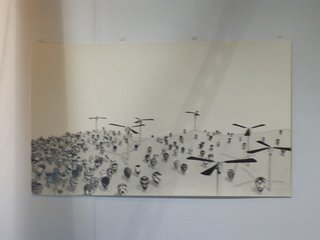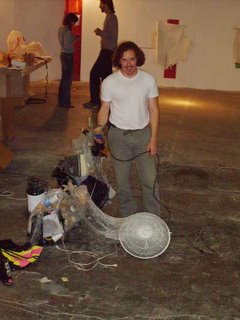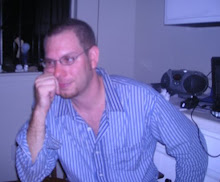Fretting over things as usual last night…
1. Has occurred to me that subject matter and media are just a mode of transportation. Maybe subject matter is a car and the medium’s the gas. They enable the artists to get where they’re going, to the content. But when you’re viewing, it’s like you’re in the car or train or whatever, and you’re not sure where you’re going. You can get off at any number of undetermined places, but the end of the trip, the secret, predetermined destination that holds the whole, true meaning, is being led up to all the time. (and of course never completely reached) And you get out and you still don’t know where you are, but you see the landscape and it’s some kind of culmination of the whole trip.
2. I am always thinking about the differences between subject matter and content. Can they be the same thing? Yes, I think that is Formalism- the meaning is in how the object looks/the formal elements of the media. When it is different, I guess I might have a painting of The Last Supper where the dinner setting and people are subject matter and the content is…conviviality? Maybe that example is too literal- change the subject matter to 2 people in conversation and the content could be determined by the expressions- a lascivious look/an argument/etc. What is the artist saying about the conversation? With Pollock, let’s say the subject matter is paint splatters- at least that is what we see, but the subject matter must also be his process, because it’s about the paint, hence painting- that is what we talk about, and we “see” that too. So the content becomes the mystical conjuration of a feeling/atmosphere through paint and action. Then, in Conceptual Art, I think the distinction is usually much easier- as in Sol Lewitt’s open cubes, where the subject matter is obviously the open cube, but the content has to do with a finite, open system, possibilities therein, etc. Now here I have another sticking point, which is the categorization of conceptual artists and material/intuitionists. With Conceptualism, the content may be different than the subject matter, but also not signified by the form itself. But the open cubes and their documentation are the signifiers aren’t they? Perhaps it is meant to be in the formulaic ability for replication, that the form itself is almost irrelevant compared with the idea. BUT THEN HOW CAN WE GET RID OF THE WHOLE CREMASTER CYCLE AND STILL HAVE THE IDEA?! Matthew Barney is not a pure conceptualist, I think I just refuse to believe this. The new generation of conceptualists bastardize the thing, I think- even though through Barney’s sketchbooks, production qualities it need not be created by one artist’s hand…ok next point
3. Which leads to another question/ sticking point/ paradox: the double-edged subjectivity-objectivity sword. Go back to Pollock and his objectifying of the paint through manhandling the splatters around. It’s obviously not completely objective since he edited/cropped his canvases after painting, but how much more obviously could you just show the qualities of the paint than his splattering? And you would think that this would be purely self-referential in its object-hood, but it obviously isn’t because we get all sorts of other ideas from this! But consider also all the meanings of “objective”: pertaining to an object; impartial; a goal, goal-oriented. I always think that this variety of meaning is important. I’ve always thought, also that self-referentiality is impossible, and in it’s place a conceptualism reference starts to emerge. For instance, a reductionist, white square may physically only reference the shape of the canvas, the paint, but the question of why may lead the viewer back through the entire history of abstraction.
4. Art that frustrates me because it doesn’t immediately strike a note: I was embarassingly presumptuous in ranting about this the other day, sometimes I am not patient enough and realize that ultimately certain works may become more relevant to me in the future. But let’s be honest- there’s a lot of boring art (I should say uninteresting art, to make it clear that I am not equivocating art’s function with entertainment) or art made in bad taste (and by this I do not mean just sex and poo but the loud or obnoxious stuff and you know art that’s cliché “arty” now- like body painting and slashed canvases in most cases- but not Paul McCarthy, I like him), or art that is popular due to a market whim, or art that is imitating someone else or appropriating everything or simply “been done before” in a noticeable way or whatever. It took me a little while to understand and like Hendrix, jazz, and coffee, Shakespeare, and even olives- so really the whole Michelangelo/Kosuth ease of translation thing was probably me being full of crap. I like not understanding because it often draws me in, but I also like/have a right to be a discerning viewer. And sometimes I feel like conceptual art can be an excuse to not do much, as abstraction can be an excuse for sloppy painting- and sometimes that sucks, especially for the really great sloppy painters and brilliant people who don’t do much!
To sum up- maybe some of you have guessed that I get a little neurotic about these issues and like to sit the fence (hey I know I’m a student, but the pressure to sound like I know what I’m talking about in front of an anonymous public of “chastisers” is kinda scary).. it really does infatuate me and I tend to go back and forth between theories and positions till I am thoroughly dissociated from myself and at which point I actually manage to get some “real” work done. I get very frustrated with paradoxes and dichotomies, but they are also really The Spice of Life. I like them though they confuse me, and I like jumping from one side to another without feeling that either is any better, or that there is anything wrong with the jumping, but definitely call me out when I’m spewing crap, and t.y. to my various Chastisers (I can now see this blog becoming conceptually masochistic, so feel free to let me know if I’ve got something right too!).



















































